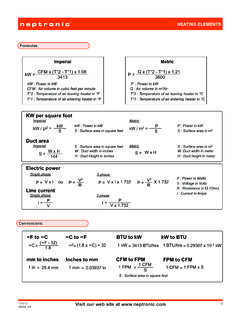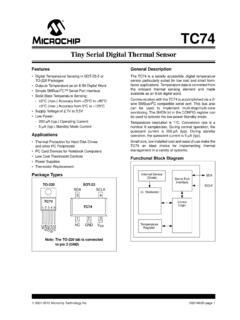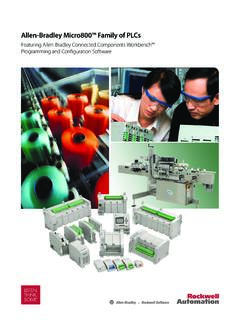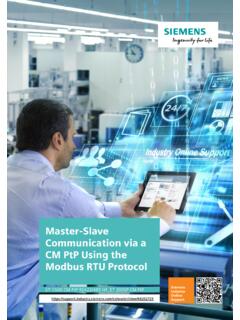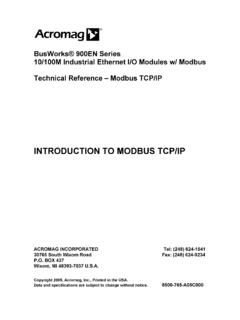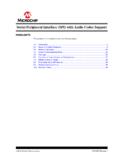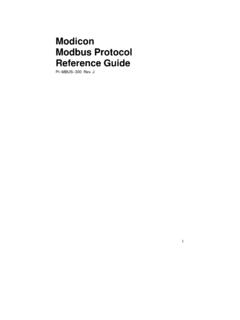Transcription of BACnet MS/TP Overview Manual
1 BACnet MSTP Overview BACnet MS/TP Overview Manual This Manual includes: Network Wiring Guidelines BACnet Address (Mac & Device Instance) - Setting Information Baud Rate - Setting Information Trouble Shooting Tips BACnet MS/TPOverview Manual Page | i Contents Introduction .. 1 About BACnet .. 1 About MS/TP Protocol .. 2 EIA-485 .. 2 Wiring .. 2 Network Cable Type .. 4 Maximum Number of Devices .. 4 Maximum Network Length .. 4 Shield Wiring Recommendations .. 4 End of Line (EOL) Termination .. 5 Repeater Usage .. 6 Addressing .. 8 Baud Rate .. 8 Addressing .. 8 Device Instances .. 8 MAC Addresses .. 8 master - slave .
2 8 Max master .. 8 Optimize MAC Address & Max master .. 8 MAC Address Settings via DIP Switches .. 9 Troubleshooting Tips .. 9 BACnet MS/TPOverview Manual Page | 1 Introduction The BACnet MS/TP Overview Manual details the concepts of BACnet and MS/TP . About BACnet BACnet is a data communications protocol for Building Automation and Control Networks. It is an approved and standard protocol by American Society of Heating, Refrigerating and Air Conditioning Engineers (ASHRAE), American National Standards Institute (ANSI), and International Organization for Standardization (ISO). The BACnet protocol supports communication and control of applications such as heating, ventilation, air-conditioning, lighting, access, and fire detection systems and their associated equipment.
3 The communication protocol consists of a set of rules that monitors data that is exchanged between devices, enabling communication among devices in a network. The exchange of information can include values of temperature, humidity, alarm status and so on. To communicate between devices, the BACnet protocol uses services and objects. Service. A service is a means or interface between two devices to access and process information, request to perform an action, or inform the devices that some event has taken place. These are used for discovering devices and objects, and for sharing data. Refer to the appropriate BACnet guide of the device used to verify which services are supported. The following are some of the important services: o Who-Is (Device and Object Discovery) o I-Am (Device and Object Discovery) o Who-Has (Device and Object Discovery) o I-Have (Device and Object Discovery) o Read-Property (Data Sharing) o Read-Property Multiple (Data Sharing) o Write-Property (Data Sharing) o Write-Property Multiple (Data Sharing) o Subscribe COV o Subscribe COV Property o Confirmed COV Notification o Unconfirmed COV Notification Object.
4 An Object along with its set of properties describes the current status of a device to the other devices on the network. Objects enable reading, writing, and performing the desired functions of a device. Refer to the appropriate BACnet guide of the device used to verify which object types are supported. The following are some of the objects: o Analog Input o Analog Output o Analog Value o Binary Input o Binary Output o Binary Value o Device o File (available on recent specific models only) o Multi-State Value o Program (available on recent specific models only) o Schedule (available on recent specific models only) BACnet MS/TPOverview Manual Page | 2 About MS/TP Protocol The BACnet master slave Token Passing ( MS/TP ) protocol is used to relay and exchange information between building devices.
5 The MS/TP is a based on BACnet standard protocol SSPC-135, Clause 9. The BACnet MS/TP is a peer-to-peer, multiple master protocol based on token passing. A token is information packets in the form of a pulse signal that is passed between devices on a network. EIA-485 The BACnet MS/TP protocol uses EIA-485 (RS-485) as the physical layer standard for data transmission. Neptronic Controllers also use the BACnet MS/TP protocol over an RS-485 standard for communicating with third party routers, gateways, or master controllers. Wiring The communication wiring must be installed in a proper daisy chain format. Daisy chain configuration means that there is only one main cable and every network device is connected in parallel directly along its path.
6 It is important to keep the same color for all the A+ wiring and a different color for all the B- wiring. Do not use a free topology and/or star configuration on the network. This will cause reflection issues. Illustration 1 - MS/TP Network Configuration Example Here is an illustration of the correct MS/TP network wiring; *Indicates non Neptronic devices or equipment. Illustration 2 - MS/TP Network Correct Wiring BACnet MS/TPOverview Manual Page | 3 Here are a few tips for the network wiring: Avoid unwinding the twists of cable when not necessary. Twisting the insulated conductors around each other reduces outward noise and improves immunity to external noise pickup.
7 Avoid exposing too much bare wire so that adjacent wires do not short when connected to the controller. Twist the two A+ wires together before inserting them into the corresponding screw terminal of the controller. Avoid running network cables near DC signal switches, variable frequency drives and power lines (sources of electricity). These are the most common sources of induced noise. Secure the network cables to reduce vibration as much as possible. Do not use T-taps (pig tails) on the network. Controllers may drop out of the token pass or packets may be lost. See illustration below for examples of T-taps. EOLEOLEOLW hiteBlueWhiteBlueEOLEOLEOL *Indicates non Neptronic devices or equipment.
8 Illustration 3 - T-taps (pig tails) You should avoid using the In and Out terminal screws for communication. If the terminal block is removed the daisy chain will be broken and you will lose all the devices located after. Illustration 4 - Communication In/Out BACnet MS/TPOverview Manual Page | 4 Network Cable Type Neptronic recommends using low capacitance, EIA RS-485, 22 or 24 AWG shielded twisted pair cables such as Belden 9841 or equivalent. You should always verify the Specification & Installation Instructions for the suggested cable type and size. Maximum Number of Devices The Neptronic MS/TP network supports a maximum of 127 devices (with one or more repeaters) or 64 devices (without a repeater).
9 We recommend using a maximum of 64 devices to reduce traffic and minimize network response latency. If more than 127 devices are required on the total network, then use extra BACnet MS/TP routers. When 64 devices are on a single MS/TP segment, we recommend using a baud rate of 38,400bps with a maximum network wire length of 4,000ft (1,200m). Note that each MS/TP supervisory controller and repeater counts as a device Maximum Network Length BACnet MS/TP allows the total length of the twisted pair bus to be up to a maximum of 4,000 feet (1200 meters) using data rates from 9,600 to 100,000bps. This condition is only valid when proper installation and cables are used. The maximum baud rate supported by the Neptronic BACnet controllers is 76,800bps.
10 If a network requires more than 4,000 feet (1,200 meters) in length, then repeaters must be used to extend the trunk length. Shield Wiring Recommendations Do not use the reference (COM) terminal on the controllers to wire the shields. Shields from each feed of the network connection to a controller should be wired together. Special attention must be taken to ensure that the shields are well protected (ends tapped or covered) to prevent any connection to ground that could influence the shield reference. This could create ground loops and change the reference level of the network. The shield in a daisy chain format is then grounded at one end only (usually on the supervisory controller or router side). Do not ground the shield at more than one location as you may induce ground loop noise.





